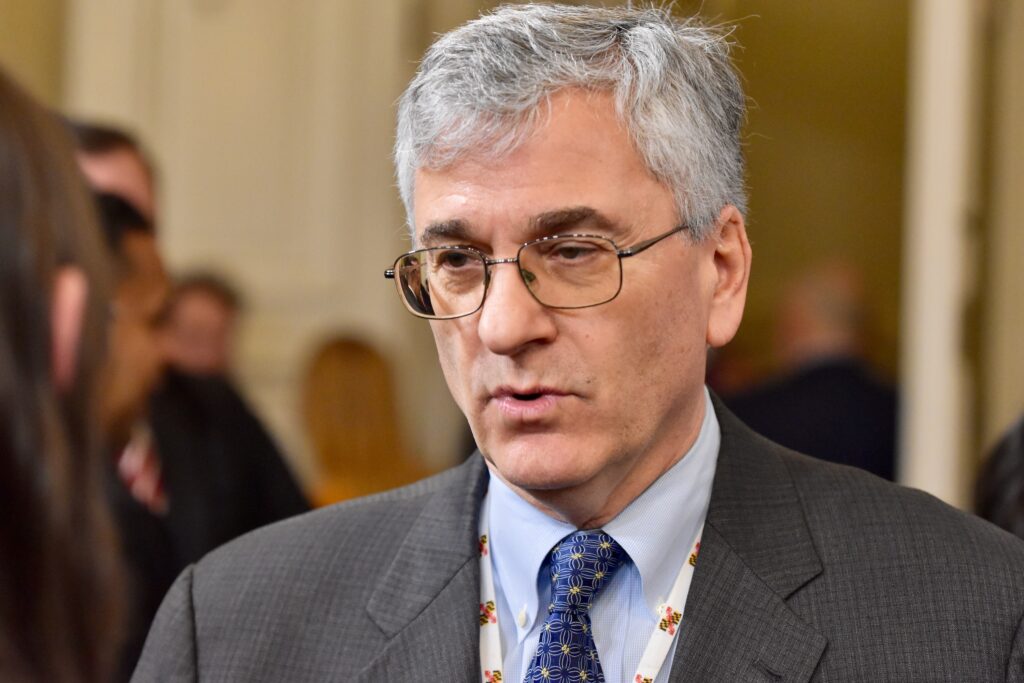
Maryland Department of Juvenile Services Secretary Vincent N. Schiraldi in January 2024. File photo by Bryan P. Sears.
Last month, while activists were petitioning Gov. Wes Moore to fire the secretary of the Department of Juvenile Services, Vincent Schiraldi, for not using his limited authority to cage more kids, I was at my organization’s poetry showcase listening to first- and secondhand accounts of system-involved youths’ traumatic experiences of dehumanization and separation from their community.
The show, titled “Your Voice Matters,” highlighted the perspectives of some of the 29,000 youth that our country detains every year. Our staff from the Sayra and Neil Meyerhoff Center for Families, Children, and the Courts (CFCC) helped the performers from Baltimore City Public Schools and young people from the University of Maryland Baltimore County’s the Choice Program, to express the pain, confusion, and hopelessness that wound children in youth jails and detention centers.
I wish the people who signed that petition had joined us that evening. The poetry showcase dispelled stereotypes about youth who commit violent acts, and highlighted their needs for community connections and a chance to develop. Youth shared their longings for guidance, safety and justice through narratives and poems. Their experiences justified the evidence-based reforms Schiraldi has implemented in the short time he has led the agency.
Our showcase kicked off Youth Justice Action Month (October) and our symposium, “Keeping Youth in Community: Policies, Practices, and Programs to Promote Youth Justice.” CFCC hosts an annual symposium that strives to create a brave space where speakers confront the tough issues and attendees ask the hard questions and refine their perspectives.
I wish that the people who are calling for Schiraldi’s removal had joined our symposium. There, we discussed what many of our fellow Marylanders seem to be noticing – namely, that the system we have is not working. All of us (and especially young people, i.e., the demographic most often victimized by youth crime) want responses to youth acts of violence that restore our sense of community safety.
Our symposium speakers – which included impacted individuals, advocates, a high school student leader, a prosecutor, a public defense attorney, government agency staff and a judge – taught us about what works to prevent and address youth crime. Our keynote speaker, Nate Balis of the Annie E. Casey Foundation, presented innovative models being used to prevent youth offending and restore a sense of community safety. These models contain some of the following elements: mentorship (often delivered by credible messengers), restorative justice principles, positive youth development approaches, such as employment training, education support and enrichment opportunities.
These are the keys that unlock youths’ connections to their communities and prevent youthful offending. Many of these elements aren’t available to youth while they are detained. This makes detention not only harmful, but also a missed opportunity for developing protective factors against reoffending.
Unfortunately, the system that Schiraldi inherited was not designed to optimize community safety or guide youth through an accountability process. Approximately 62% of the youth who are confined haven’t physically harmed anyone. But the system we have now allows youth to be harmed and humiliated while they are isolated from their communities.
The system we have now does not equip youths’ families or communities to help them navigate the harm they’ve caused, or the harm and humiliation they experienced in detention. Our current system has long waitlists for high-quality youth substance-use disorder treatment and mental health care. The research is clear that isolating youth from their communities in youth prisons or adult jails does not decrease their likelihood of avoiding delinquent or criminal behavior.
Schiraldi is working to change the flawed system he inherited. His discerning use of detention is an evidence-based approach to community safety.
Inspired, no doubt, by the governor’s “all of the above” strategy to reverse the dramatic increase in homicide rates that occurred under his predecessor, one of Schiraldi’s creations, Baltimore’s Thrive Academy, has successfully prevented gun-related crimes and violence by connecting youth to mentorship and resources in the community. Fewer than 2% of the 126 teenagers in the Thrive Academy program this past year have been shot, and fewer than 20% have been arrested for gun-related crimes.
Schiraldi’s efforts to change Maryland’s Department of Juvenile Services align with the evidence and the lived experiences of the young people. Kids need belonging and connection to develop into the best versions of themselves and learn from their mistakes.
Caging kids is not going to make us safer. But following Schiraldi’s leadership towards a system centered on evidence and community connection is likely to bring us closer to the safety we deserve.

